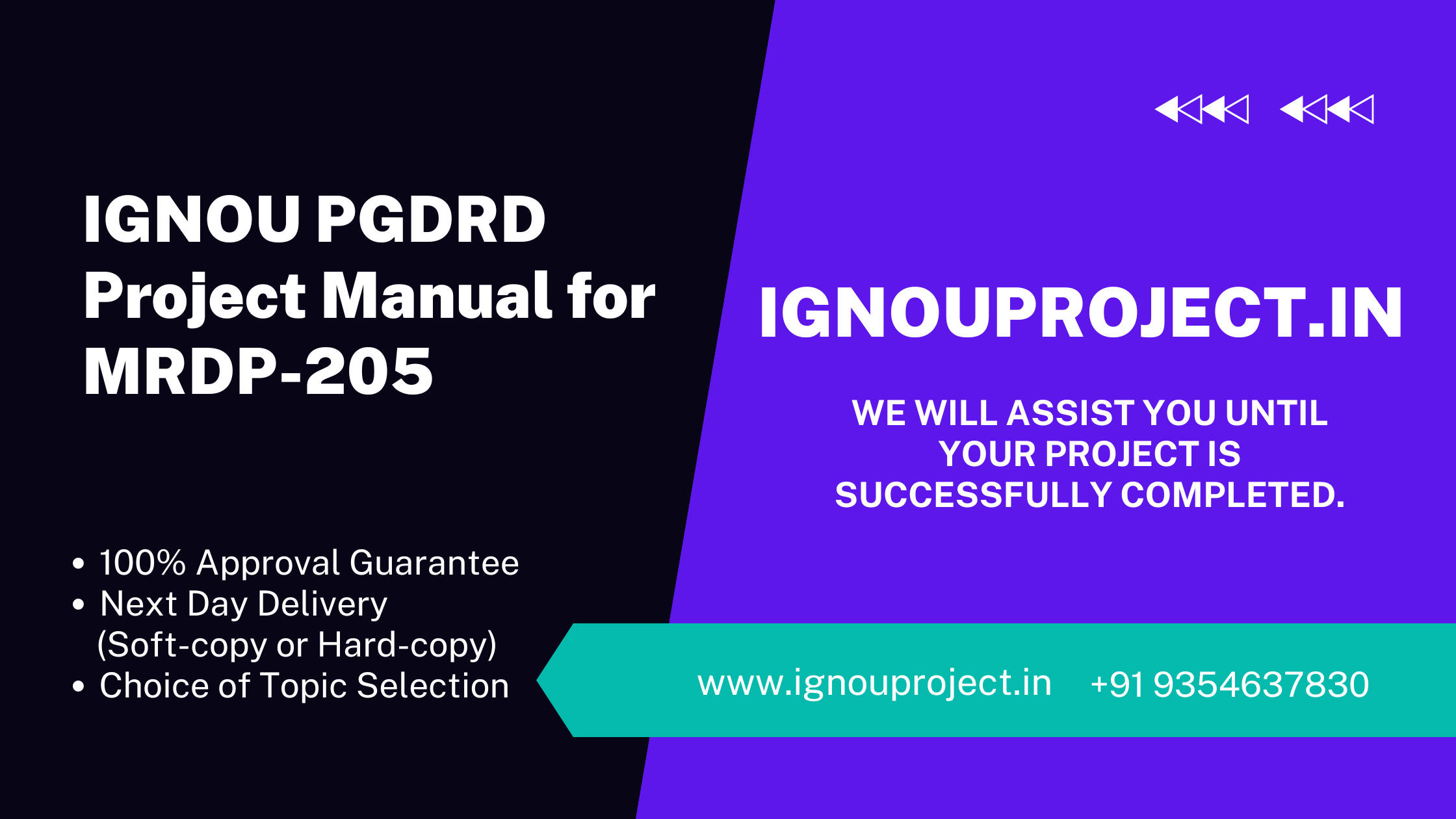Overview
Are you a PGDRD student at IGNOU, and are the project requirements causing you stress? Rest assured—we’ve got you covered! In this post, we’ll provide you with a thorough guide on how to complete your IGNOU PGDRD project (MRDP-205). We will help you with every stage of the project, from setting goals to conducting research, analyzing information, and presenting your findings. Now let’s embark on this amazing journey of completing your IGNOU PGDRD project (MRDP-205)!
WhatsApp us to get the Personalized (Customized) IGNOU PGDRD Project Report and Synopsis
An Introduction to the IGNOU PGDRD Initiative (MRDP-205)
The PGDRD Project: What Is It?
First, keep in mind that without the PGDRD project, the Indira Gandhi National Open University’s (IGNOU) Post Graduate Diploma in Rural Development (PGDRD) is not complete. It is intended to assess your understanding of concepts related to rural development, your ability to do research, and your ability to apply theoretical knowledge to practical situations.
How does one go about finishing the PGDRD Project?
You can demonstrate your grasp of rural development theory and its practical applications through the PGDRD project. It gives you the ability to do in-depth research, evaluate information, and offer solutions for problems pertaining to rural development. Your critical thinking, problem-solving, and presentation abilities will all be beneficial in the subject of rural development, and this project will help you develop all three.
Step 1: Choose the Topic for the PGDRD Project
The first step in creating a PGDRD project is selecting a topic that interests you. Think of topics that pique your interest and connect to your professional goals. It is essential to choose a topic that will enable you to carry out pertinent study and advance our understanding of rural development.
Step 2: Review the Literature on the Selected Subject
Once your project topic has been chosen, you need to conduct a comprehensive evaluation of pertinent literature. This phase will help you understand current ideas, research results, and industry best practices related to the problem you have chosen. Use reliable resources to get pertinent data, including books, scholarly journals, and reputable websites like Wikipedia.
Step 3: Formulating Objectives and Research Issues
After reviewing the literature, you need to clearly define the goals of your PGDRD project. These aims will guide your study and help you formulate research questions. Research topics should be SMART (specific, measurable, achievable, relevant, and time-bound) in order to give a focused and useful investigation.
Step 4: Formulate a Research Plan
The research methodology used in your PGDRD assignment is crucial. It outlines the procedures and strategies you will use to gather and examine data. To address your research questions, you can employ mixed-method, quantitative, or qualitative techniques. Verify that your strategy aligns with the objectives of your research and offers substantial evidence to support your findings.
Step 5: Collecting and Examining Data
After developing your study approach, it’s time to collect and evaluate data. Data can be collected through surveys, focus groups, interviews, or observations. Uphold the highest ethical standards and obtain individuals’ informed consent. Apply pertinent statistical or qualitative analysis techniques to the data you have collected to obtain important insights.
Step 6: Examine the Information and Make Inferences
Interpreting the results of your data analysis is the next step. Find links, patterns, and trends in the data that will help you find the answers to your research questions. Make inferences from your findings and relate them to the goals of your research. It is essential to support your conclusions with facts and reasoned arguments.
Step 7: Formulating Suggestions and Formulating Plans of Action
In this step, you will develop recommendations and action plans based on the results of your investigation. Determine workable solutions and tactics that can support initiatives for rural development. Your concepts should be long-term, realistic, and sensitive to the social, economic, and environmental realities of rural communities.
Step 8: Finish the Project Report for the IGNOU PGDRD
Finally, the PGDRD project report calls for a summary of your completed research and analysis. IGNOU has provided the guidelines and format for your research. Ensure a logical and concise presentation, and structure your report coherently. Make sure you correctly credit and mention your sources to prevent plagiarism.
Step 9: Outlining and defending your project
Finally, the last stage in finishing your PGDRD project is to present and defend your work. Create a compelling presentation that focuses on the key elements of your research, including the goals, techniques, conclusions, and suggestions. While presenting, project confidence and clarity, you should also answer any queries or comments from the evaluators in a professional manner.
Frequently Asked Questions (FAQs) for IGNOU PGDRD Project.
Q1. What’s the longest a PGDRD project can take to finish?
Ans. A PGDRD project can be finished in a maximum of six months.
Q2: After my PGDRD project has been authorized, may I change its topic?
Ans. After your PGDRD project has been approved, you can change it, but you’ll need to get the necessary approvals and speak with your project guide beforehand.
Q3: Are there any formatting standards for the project report for PGDRD?
Ans. Yes, IGNOU provides formatting guidelines for the PGDRD project report. To guarantee compliance and stay out of trouble, abide by those guidelines.
Q4: Can I collaborate with other students on my PGDRD project?
Ans. For the PGDRD project, collaboration with other students is not allowed. The project should be a solo endeavor that exhibits your capacity for self-directed investigation and analysis.
Q5: How important is it that the PGDRD project choose an original theme?
Ans. While choosing a novel topic for your PGDRD project is not necessary, it does enhance the quality of your research and demonstrate your ability to look into uncharted territory in rural development.
Q6: What are the standards for evaluating the PGDRD project?
Ans. Among the factors utilized to assess the PGDRD project are the topic’s relevancy, research methodologies, data analysis, logical interpretation, helpful suggestions, and overall presentation.
In summary
Finally, finishing the IGNOU PGDRD project (MRDP-205) is a challenging but worthwhile endeavor. Following the primary steps outlined in this comprehensive guide will help you handle the project requirements with effectiveness. Don’t forget to pick an interesting topic, conduct in-depth investigation, carefully examine evidence, and effectively communicate your conclusions. If you put in the necessary effort and persevere, you can succeed in your IGNOU PGDRD project (MRDP-205) and have a positive impact in the field of rural development. Warm regards.
Ready to get your IGNOU PGDRD Project Report and Synopsis Sample PDF?
- Call us or WhatsApp us at: 9958947060, 9354637830
- Visit: IGNOUPROJECT.IN
- Read More:


